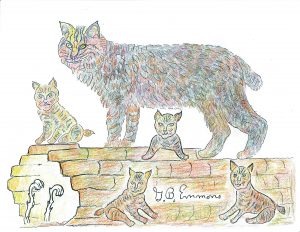The occasional sight of a bobcat is not yet too common, as it is the only known wild cat found in this area of Massachusetts.
Years ago, it was found only in central and western parts of the state, but now has been expanding into many urban areas of the Southcoast.
It is easily identified as a medium-size feline with a bobbed tail and slightly tufted ears, with black spots on its legs and underparts. It is two or three times bigger than a domestic housecat, weighing 25 to 30 pounds.
Like the coyote, the bobcat is adapting to urban settings, but being solitary, tend to stay away from people and rarely cause conflicts with human activities.
Bobcats live in dens located in rock crevices, under ledges of cliffs, or in a fallen stump of a hollow tree, as in my illustration. The females produce one litter per year consisting of up to four kittens, but only two is the surviving average.
Families are raised in the same den site for several years in a row, and the young remain with the adult female until they are full grown. All members of the family are active year-round as they do not hibernate. However, this species exhibits a crepuscular (dawn to dusk) activity that starts three hours before sunset and lasts until several hours after sunrise. They feed on various rodents, birds, snakes, rabbits, possums, and squirrels.
The bobcat is classified as a furbearing species, for which a management program and regulated hunting and trapping seasons has been established, and is considered a valuable natural resource.
Bobcats will begin to compete in domestic neighborhoods with foxes, coyotes, and of course feral cats. A feral cat usually is an abandoned domestic cat gone progressively wild depending on longevity of abandonment. Wildness in a stray feral cat is measured by its degree of progressive fear of humans. As a prowling predator to fend for itself, the feral cat becomes vulnerable as bucolic neighborhoods turn into a nocturnal predatory jungle after dark. But the bobcat can hold its own in a territorial domain, unless tangling with the now much-larger coyote that seemingly has become part wolf. Then the ensuing ruckus is a noisy snarling confrontation that quickly ends after the fur starts flying and only their pride has been hurt.
Wildlife experts otherwise consider the bobcat as the shyest creature in the forest. The cat’s extraordinary awareness of its surroundings can be explained in a scientific examination of its cranial skull. There are exceptionally large apertures next to the brain for both sight and hearing. This enables early detection of the slightest sound and movements coming from a distant direction, so one almost always sees and hears you before you are aware of its presence.
The bobcat’s larger cousin, the mountain lion, now believed to be passing through western Massachusetts, has become known as a phantom creature that is extremely camera shy, making it hard to validate their existence.
Our bobcat emits a shrill scream at night in the breeding season that sounds like a woman or child in distress. This can be hard to explain to a child being tucked in bed for the night. But we know that even breeding domestic cats can be a noisy endeavor, like when tomcats gather in an alley behind the house and emit a yowling serenade to attract a receptive feline partner.
So, don’t be surprised if a bobcat someday wanders nonchalantly through your backyard, seemingly unaware of who might be watching inside the house. But hopefully this may be a progressive sign that it is adapting to be comfortable in urban neighborhoods. Could it be that we can co-exist peacefully, maintain a mutual respect, with awareness and appreciation for the environmental?
By George B. Emmons
